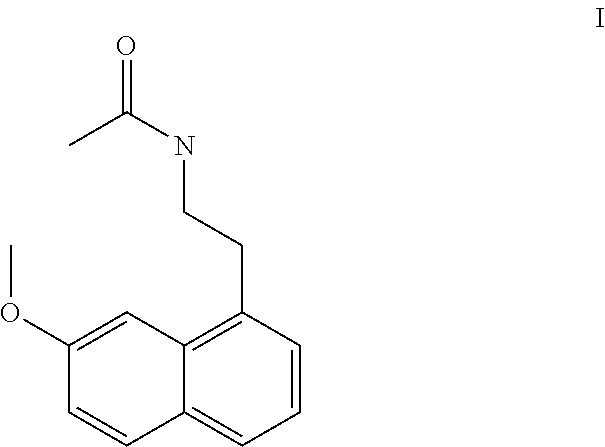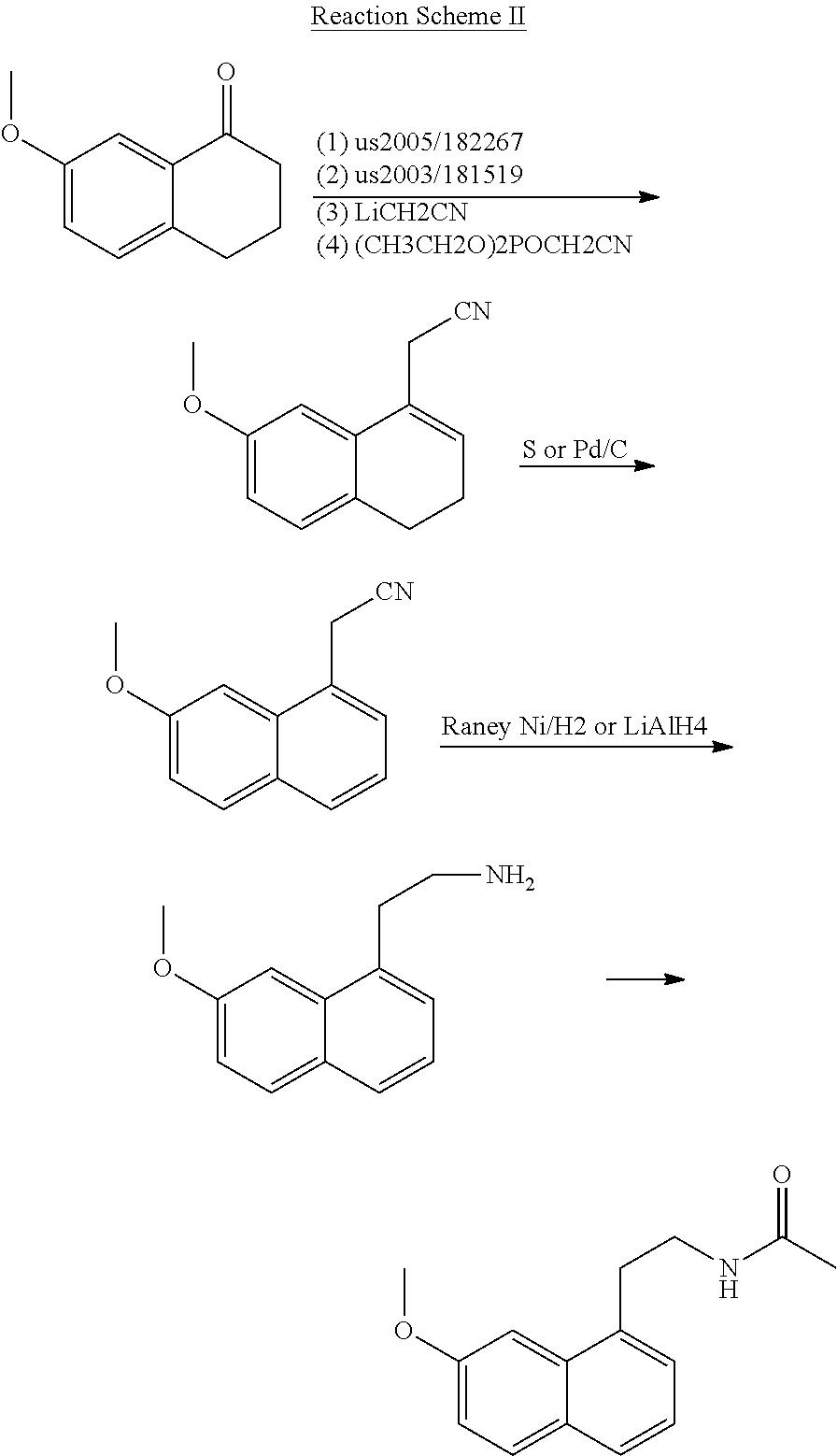Process for the manufacture of agomelatine and its intermediate
a technology of agomelatine and manufacturing process, which is applied in the preparation of amino compounds, organic chemistry, drug compositions, etc., can solve the problems of difficult to generate, difficult to generate, and difficult to obtain, and achieves the effect of convenient and simple production, easy industrial production, and convenient and inexpensive materials
- Summary
- Abstract
- Description
- Claims
- Application Information
AI Technical Summary
Benefits of technology
Problems solved by technology
Method used
Image
Examples
example 1
Preparation of N-[2-(7-methoxy-1-naphthyl)ethyl]phthalimide (II)
1) Synthesis of 7-methoxy-1-naphthylethyl Benzene Sulfonate
[0052]7.7 g of 7-methoxy-1-naphthyl ethanol (III, 7.7 g, 0.038 mol) was dissolved in 80 ml of pyridine, and a solution of benzenesulfonyl chloride (13.5 g, 0.076 mol) in pyridine was added dropwise over about one hour at −10° C. A reaction at a temperature of from −10° C. to −5° C. was allowed to proceed for 3 hours. The reaction solution was then poured into 150 g of ice water with stirring, and extracted with toluene (80 ml*3). The organic phases were combined, washed with water (200 ml*3), dried with magnesium sulfate, filtered to remove the drying agent, and concentrated under reduced pressure, to give an oil residue. The residue was recrystallized in methanol (80 ml), to produce 9.1 g of 7-methoxy-1-naphthylethyl benzene sulfonate (IV). The yield was 70%. The melting point was 86-87° C.
[0053]IR vcm-1: 1362, 1184.92, 1624.97, 1599, 1511, 1471
[0054]1HNMR (CDC...
example 2
Preparation of N-[2-(7-methoxy-1-naphthyl)ethyl]phthalimide (II)
1) Synthesis of 7-methoxy-1-naphthylethyl Benzene Sulfonate (IV)
[0060]7-methoxy-1-naphthyl ethanol (III, 7.7 g, 0.038 mol) was dissolved in 100 ml of dichloromethane, and diethyl amine (5 ml) was added, and a solution of benzenesulfonyl chloride (33.6 g, 0.19 mol) in dichloromethane was added dropwise over about one hour at 0° C. A reaction at a temperature of from 0° C. to 5° C. was allowed to proceed for 3 hours. The reaction solution was then poured into 150 g of ice water with stirring, and extracted with dichloromethane (20 ml*3). The organic phases were combined, washed with water (100 ml*3), dried with magnesium sulfate, filtered to remove the drying agent, and concentrated under reduced pressure, to give an oil residue. The residue was recrystallized in a 1:1 methanol / ethanol mixture (90 ml), to produce 11 g of 7-methoxy-1-naphthylethyl benzene sulfonate (IV). The yield was 85%. The melting point was 85-86° C.
[0...
example 3
Preparation of N-[2-(7-methoxy-1-naphthyl)ethyl]phthalimide (II)
1) Synthesis of 7-methoxy-1-naphthylethyl Benzene Sulfonate (IV)
[0064]7-methoxy-1-naphthyl ethanol (III, 7.7 g, 0.038 mol) was dissolved in 80 ml of pyridine, and a solution of benzenesulfonyl chloride (26.9 g, 0.152 mol) in pyridine was added dropwise over about one hour at 0° C. (exothermic). A reaction at a temperature of from −5° C. to 0° C. was allowed to proceed for 2 hours. The reaction solution was then poured into 150 g of ice water with stirring, and extracted with toluene (80 ml*3). The organic phases were combined, washed with water (200 ml*3), dried with magnesium sulfate, filtered to remove the drying agent, and concentrated under reduced pressure, to give an oil residue. The residue was recrystallized in 100 ml of ethanol, to produce 12 g of 7-methoxy-1-naphthylethyl benzene sulfonate (IV). The yield was 92%. The melting point was 85.5-87° C.
[0065]The data from IR, 1HNMR (CDCl3) and MS were the same as pr...
PUM
| Property | Measurement | Unit |
|---|---|---|
| pressure | aaaaa | aaaaa |
| temperature | aaaaa | aaaaa |
| molar ratio | aaaaa | aaaaa |
Abstract
Description
Claims
Application Information
 Login to View More
Login to View More - R&D
- Intellectual Property
- Life Sciences
- Materials
- Tech Scout
- Unparalleled Data Quality
- Higher Quality Content
- 60% Fewer Hallucinations
Browse by: Latest US Patents, China's latest patents, Technical Efficacy Thesaurus, Application Domain, Technology Topic, Popular Technical Reports.
© 2025 PatSnap. All rights reserved.Legal|Privacy policy|Modern Slavery Act Transparency Statement|Sitemap|About US| Contact US: help@patsnap.com



